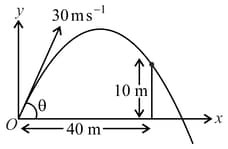Embibe Experts Solutions for Chapter: Kinematics, Exercise 3: Exercise-3
Embibe Experts Physics Solutions for Exercise - Embibe Experts Solutions for Chapter: Kinematics, Exercise 3: Exercise-3
Attempt the practice questions on Chapter 4: Kinematics, Exercise 3: Exercise-3 with hints and solutions to strengthen your understanding. Beta Question Bank for Engineering: Physics solutions are prepared by Experienced Embibe Experts.
Questions from Embibe Experts Solutions for Chapter: Kinematics, Exercise 3: Exercise-3 with Hints & Solutions
Two cars travelling towards each other on a straight road at velocity and respectively. When they are 150 metre apart, both drivers apply their brakes and each car decelerates at until it stops. How far apart will they be when they have both come to a stop in meters?
Two trains and and long are moving in opposite directions on the parallel tracks. The speed of shorter train is times that of the longer one. If the train take seconds to cross each other then find the magnitude of in ?
A man crosses a river in a boat. If the crosses the river in minimum time he take minutes with a horizontal drift . If he crosses the river taking shortest path in minutes then find shortest distance for crossing the river in .
A projectile is thrown with speed making angle with horizontal at . It just crosses the two points at equal height at time and respectively. Calculate maximum height attained by it in meter.
A food package was dropped from an aircraft flying horizontally. before it hit the ground, it was at a height of , and had travelled a distance of horizontally. Find the altitude of the aircraft in .
Two particles are projected from the two towers simultaneously, as shown in the figure. What should be value of '' for their collision in meter.

A particle moves with velocity from a point . At the same instant a particle , moving in the same plane with velocity passes through a point . The co-ordinate of the point where the particles collide is.
A particle is projected from a point with an initial speed of to pass through a point which is from O horizontally and above . There are two angles of projection for which this is possible. There angles are and . The value of is

